This presentation reflects a Command Post Exercise (CPX) that was conducted with a platoon of British Army soldiers using the Commercial Off The Shelf (COTS) PC Game 'Wargame Red Dragon' (WRD). The following article (also downloadable as a PDF) explains in greater detail why and how the activity was conducted.
The author is a British Infantry Major who at the time of conducting the events was a Captain in charge of a rehabilitation platoon.
Broken Body, Active Mind
Being the commander of a rehabilitation platoon could easily be viewed as an undesirable posting. All my soldiers were unable, through injury or sickness, to participate in the full range of training that I was used to running as an infantry officer. The post also naturally comes with a heavier burden of medical, welfare and policy bureaucracy which must be learnt, if not entirely mastered, in order to promote the recovery of the platoon. The nature of a rehabilitation platoon, however, makes it ideal for conceptual development. Indeed the minds of the broken (no disrespect intended) are in desperate need of stimulation and focus to avoid fixating on their plight, often prolonging their recovery and, for some, triggering their intention to leave the service altogether. The format for a typical day would see the troops under dedicated physiotherapists and injury specialists in the morning so by the time I got them for afternoon lessons they were generally fatigued. Therefore, the more practical I could make the lessons, and the more interaction involved generally, the better the outcome. The example in this article is but one iteration of a series of practical professional military education (PME) activities, largely centred on the use of wargaming, I employed to teach my soldiers. Those that came before me, and those that followed me, not doubt did things differently. That is, of course, their prerogative and the pleasure of one’s own command. I do not seek to compare methods, only to share what I consider to be an effective technique that others could replicate and improve upon.
Bill Bennott - 'How we walk with the broken speaks louder than how we sit with the great.’

Figure 1: 'Highway to Seoul' map (3vs3) with operational overlay superimposed.
Birth of an idea
Walking into the lines after duty one evening I discovered several of my charges playing a commercial PC game ‘Wargame Red Dragon’ in some form of multiplayer engagement. There was an electric sense of competition and associated bragging rights for the winner. Some casual enquiries revealed who the ‘best’ players of this little clique were. After a short discussion I had their support for using the simulation to train them in the upcoming Defensive Doctrine module. I decided that the best way to incorporate the simulation was as a CPX timed to assess conceptual understanding of defensive doctrine taught by traditional methods.
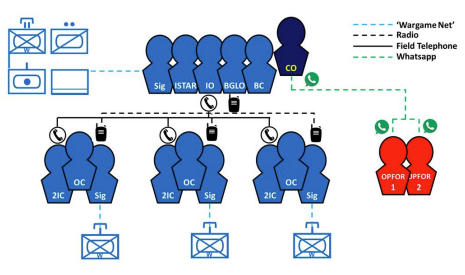
Preparatory work
I set about identifying a multiplayer map (3x3) that was would suit the scenario, pitting a BLUFOR Armoured Infantry BattleGroup (BG) in area defence against a larger mechanised REDFOR. The decision to simulate armoured forces was three-fold. Firstly it provided more variety of force elements for the participants to play around with and help develop their understanding of the Army (remembering that not everyone wants to be a light infantryman, or indeed an infantryman of any sort). Secondly, armoured forces were more survivable and mobile than light infantry which, in WRD at least, have a tendency of dying in vast quantities if not kept in hard cover! Finally, it was something different to the normal (the troops would say ‘boring’) light infantry on light infantry fight with which they were well versed. I had to build three types of ‘deck’ – BLUFOR Company (Coy), BLUFOR BG headquarters (HQ) and REDFOR Battalion (Bn) using the armoury in WRD. The battle would be fought between two REDFOR players (each a reinforced Bn) and four BLUFOR players (three Coys and one HQ) on a 3vs3 size map. 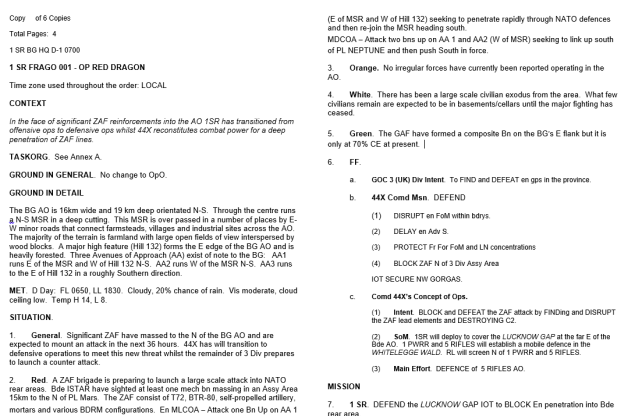
Figure 2: Front page of the FRAGO given to the Coy Comds - you can incorporate as much Operational Staff Work as you deem worthwhile into the simulation
However, a 3vs3 multiplayer map is HUGE! Too big for one BG to conduct area defence. Creating an operations trace, I managed to limit the BLUFOR to a 16km wide by 19km deep Area of Operations (AO). Additional staff products included a BG fragmentary order including outline taskorder and an exercise Master Events List (MEL). I made the decision to restrict the enemy forces to a script so that the necessary training objectives could be controlled. However, the BLUFOR were not aware of what the enemy would do and as far as they were concerned it was pretty adversarial. I must stress that the MEL was a framework to control the exercise and did not stop the REDFOR acting with initiative in the serials they were told to conduct – their impressive performance against the BLUFOR bears this out.

Figure 3: In game screenshots of the modelled vehicles and infantry that the rifle company teams would command.
The Set up
I knew I had to conduct the exercise using existing infrastructure and resources (I think we can all agree PME needs to look cost neutral if it is to be endorsed). Fortunately I was in possession of enough real estate to spread the necessary exercise cells out, and my soldiers, being millennials, had enough flat screen TVs, laptops and assorted cabling to run a brigade ops room. The large classroom would serve as BG Main – it was about the size of a light Infantry Main HQ (but much more comfortable). We would only simulate the operations/battle tracking side – using the large projector screen as our ‘live map’ with a chopped down BG staff. I would stand in as a hybrid of the Operations Officer (OpsO), Chief of Staff (COS) and Commanding Officer (CO) to assure the Main functioned as a coordinating body, but I wanted those who were playing the Coys to have as much freedom and mission command as possible (sadly not often replicated in my own training experiences). The set up was conducted by the participants themselves, including any troubleshooting with wifi; no simulation experts were required.
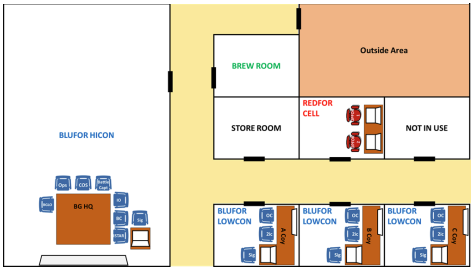
The first stage of the simulation involved the troops working in their respective Coy cells conducting Initial Preparation of the Battlefield (IPB) and Surveillance Target Acquisition Plan (STAP) in their assigned AOs. An advantage of using area defence as the framework doctrine for the exercise was that I, as the CO, was able to site ‘two down’ with platoon ‘goose eggs’ thus simplifying the work of the subordinate cells. A day or two prior to the exercise I had taught the rudimentary elements of Security Threat Assessment (STA) planning so the troops were quick to generate named areas of interest (NAIs) and targeted areas of interest (TAIs) to pass up to the BG HQ.
I 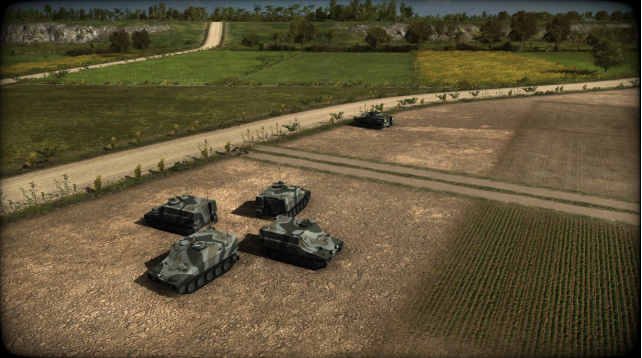
Figure 4: BG Main HQ in the simulation, the CO's Infantry Fighting Vehicle (IFV) is in the background. This location would be destroyed by REDFOR artillery before the end of the exercise.
I insisted that only three forms of communication were possible during the exercise: the first was radio (which we would not use until contact with the enemy had been achieved), the second was line telephone (which took some getting used to) and the third, the Coy dispatching their command vehicle to the location of the BG HQ in the simulation - and only then could a member of the cell physically walk over to the HQ cell to hold a face to face.
You can’t hit what you can’t see – but if you are seen you will be hit!
Quite early on the BLUFOR team’s reconnaissance elements were either destroyed, driven back or dislocated by the enemy’s axis of advance. This left those in the BG HQ largely blind to what the REDFOR was up to.
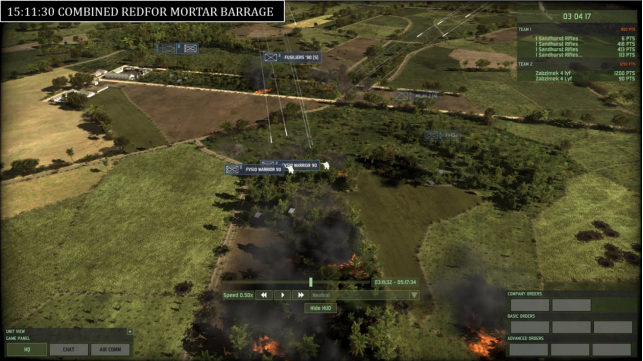
Figure 5: One of several examples of the REDFOR using indirect fire to make BLUFOR pay for massing their forces together.
They did not know where the REDFOR were planning to attack or in what strength – and crucially they had no idea where to apply their significant artillery support. On the flip side, the REDFOR wasted no time in conducting detailed and persistent reconnaissance of the BLUFOR positions, which unhelpfully remained largely static even once combat was joined. Once any sizeable BLUFOR element was discovered the REDFOR were quick to apply indirect fire; mortars being the most frequent example. REDFOR was also cognisant of BLUFOR counter battery fire, moving after a short salvo had achieved sufficient disruption so that BLUFOR’s counter barrage landed harmlessly behind them.
Amateurs Talk Tactics
The experience highlighted that there is little substitute for tactical proficiency. The REDFOR players were experienced and handled their forces adroitly; implementing bounding over watch, carefully planned reconnaissance and rapid reaction to threats with pre-positioned fires. Although they didn’t know where the BLUFOR were located, they had conducted a hasty IPB and were very good at ‘feeling out’ the edges of the defence without getting bogged down in a substantial firefight.
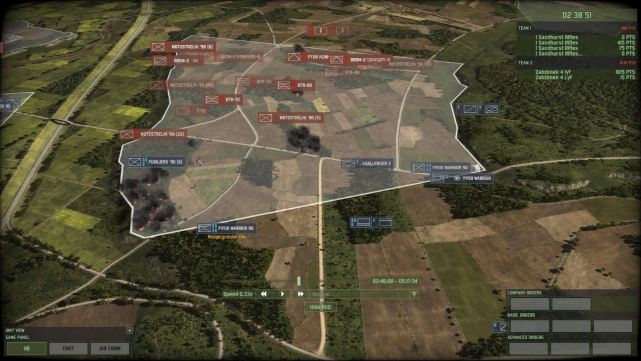
Figure 6: The aftermath after a reinforced REDFOR Coy attacked a BLUFOR Coy holding the shaded area. BLUFOR lost nearly 50% of their strength including all their tanks and specialist anti-tank weapons.
One of the BLUFOR Coys deployed quite poorly with their infantry mounted and anti-tank weapons and tanks held in the rear, unable to cover likely enemy approaches. What is more, when the REDFOR launched their attack, they failed to relinquish the ‘hold fire’ command until several of their units had been destroyed. On more than one occasion Challenger tanks were sent into wooded terrain without infantry support and were killed by enemy infantry firing Light Anti-Armour Weapons (LAWs) at the exposed rear of the tanks. The combat ratios were near enough 1.5:1 RED to BLUE in any given attack situation – given that BLUFOR were in defence they should have easily bested the REDFOR, according to our operational analysis and understanding of doctrine. However instances of BLUFOR poorly positioning their fighting vehicles, concentrating their vehicles and troops into indirect fire (IDF) targets, failing to guard the flank, failing to interlock fields of fire and failing to release weapons control all contributed to make that 1.5:1 ratio less and less risky for the REDFOR player.
REDFOR, by contrast, employed basic tactics very well: they avoided crossing open terrain if they could help it, and when they couldn’t they employed artillery delivered smoke and high explosive (HE) against likely BLUFOR positions and then used all possible speed to cross the Killing Area in force. REDFOR linked their sensors to shooters with impressive speed, using fires to both initiate and break clean from their attacks. As ever in training, you can learn as much from your enemy as you can from your own forces' performance.
Professionals Talk Logistics
Unsurprisingly the logistical needs of the force were not fully thought through by the training audience. The two areas that were most apparent were fuel and ammunition. In WRD moving tracked vehicles across the map (not using the road network) consumes fuel at a huge rate (the game also models each vehicle’s fuel consumption rate, speed and fuel tank capacity). At one point BG Reconnaissance vehicles nearly ran out of fuel trying to withdraw in front of the advancing REDFOR because they had not factored in a refuelling since making a long road move up to the front of the BG AO. During the final attacks some vehicles were charging into enemy positions with empty fuel tanks because the Coy commanders had failed to appreciate the distances they would have to traverse in the attack.
The Battery Commander in my exercise was prolific in his use of fires – largely speculative; resulting in high damage to the team’s logistic stock of ammo but very little damage to the enemy. The poor BG Logistic Officer discovered with horror that the artillery battery had consumed the entirety of the team’s battlefield stores at a critical juncture – preventing much needed resupply to the manoeuvre Coys. Fighting logistics through became a common theme - towards the end of the battle a single logistic vehicle conducted a ‘thunder run’ resupply effort to a Challenger tank that was low on fuel. The driver of the vehicle managed to negotiate their way through two sequential rocket barrages (even a graze from one rocket impact would have destroyed the vehicle) – medal worthy stuff!

Figure 7: The 'Forward Operating Base' in WRD holds the team's supplies (fuel, ammo and spares) that can be ferried to the fighting units via unarmoured logistic vehicles.
Limitations and options for using WRD as a PME tool
I would offer the following advice to anyone wishing to try this out at their units . Familiarise yourself with the game – the controls, the units, maps and mechanics – only then will you understand what it can and cannot accurately simulate. For example, in its current format the game does not allow for entrenchments, minefields or other obstacles to be placed or cleared. It also does not simulate chemical weapons, Improvised Explosive Devices and Electronic Warfare, nor does it allow for detailed urban operations or complex light infantry tactics. Civilians are also wholly absent, something the futurists tell us will no longer be the case in emerging conflicts.
That said the base game provides significant scope to explore. If you looking to discuss and test Ground Based Air Defence (GBAD) doctrine, then you have the option to site various types of AAA/AA missile systems and interceptor aircraft over a piece of key terrain or infrastructure and see how it fares against a squadron of enemy ground attack planes. Do you want to practice counter battery fires and moving batteries around an artillery manoeuvre area (AMA)? Then create a game with predominantly artillery forces and see whose tactics prove the best at surviving beyond the first salvo. As a Javelin (Anti-Tank) Platoon Commander I rarely got to test my anti-armour planning skills. WRD allows anti-tankers to conduct reconnaissance, site their locations and test them against modern tanks. Naturally, any scenario will need some thorough testing by its designer to assess what can be modelled and what may need to be abstracted due to simulation limitations.
Player familiarity with the controls and mechanics are essential if you are to use the simulation as a tool for learning. You should consider allocating a few hours of playing the game against the Artificial Intelligence or each other prior to any formal training session. YouTube contains numerous videos that explain basic controls, tactics and the game mechanics and I strongly recommend these are made available to any training audience ahead of the simulation.
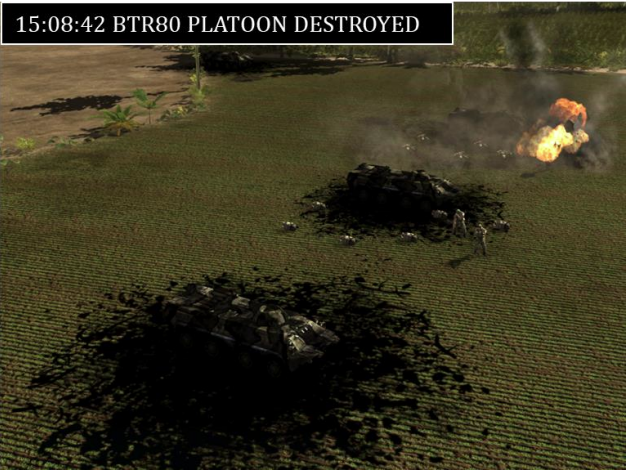
Figure 8: Combat in WRD is unforgiving. The simulation stresses husbanding your forces and not to fritter them away in badly planned engagements
As the Exercise Director, try to have a method of exercising control over the simulation – I used an enemy MEL but you may find that having a list of possible serials or set timings for gameplay to start and stop are also effective. There is an inherent danger that the exercise could devolve into a game – unless that is the training objective you are trying to achieve. Having a prepared method to conduct an After Action Review (AAR) also helps – are you going to try to take screenshots throughout the exercise or use the in-built replay feature to watch the exercise back in real/faster time?
If you have the time then you can expand the exercise to include receipt of orders, planning, course of action wargaming, orders, rehearsal of concept (ROC) drills etc before the simulation actually goes live. You can even split the exercise into two discrete simulations. For example you could start with a REDFOR Coy commander being given free play to establish a defence within a certain area. A BLUFOR reconnaissance commander is then given a certain number of assets and time limit to conduct reconnaissance of the area and his report will then shape the BG commander’s planning. This in turn will lead to the full BG plan and the second simulation is the execution of the offensive plan. Inject additional frictions such as a ‘Bde Comd’ visit for a back brief and a simulated cyber attack shutting down BG HQ for a set period of time, or test the mission command ethos of the unit by destroying the HQ with an artillery strike and see how the Coy commanders react without their CO's influence.
Conclusion
Wargame Red Dragon will not be the solution for every training scenario – how could it be when it was designed as a source of entertainment for a non-military audience (just reading the online forums reveals most players have never served). All I assert is that it could be a simple, off the shelf, low cost, low headache option for a PME session you are thinking about running in the future. Even its limitations allow for further discussion (so how would an obstacle plan have changed the outcome of that engagement?), and who knows, perhaps someone is creating a battlefield engineering module as we speak. My final advice - give it a go, you may be surprised by what you can achieve.









